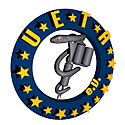German organized tattoo artist
| German Organized Tattoo Artists eV (DOT) |
|
|---|---|

|
|
| founding | 1995 |
| Seat | Frankfurt |
| purpose | Establishing and monitoring hygiene standards, cooperation with authorities, information via the press and other media. |
| Chair | Friedhelm van Genabith |
| Website | dot-ev.de |
German Organized Tattooers eV (DOT) is the oldest, official professional association of professional tattooists in Germany. He is the initiator of hygiene standards in the German tattoo industry.
history
The DOT was founded in 1995. The founding members included Tommy Köhler , Dieter Zalisz, Hans-Joachim Monien (Hängo), Ralf Guttermann (†), and Heribert Nentwig (Herry), who was also the first president of the European Union of Tattoo Artists (UETA). In cooperation with the Hygiene Institute Gießen, Nentwig has developed guidelines for hygiene and sterilization in tattoo shops. "Anyone who wants to be admitted to the DOT must have taken part in a hygiene seminar at least once, have five years of professional experience and artistic talent." The members of the DOT have their hygiene standards checked every three years.
Initiatives
In 2004 the DOT initiated the founding of the UETA (United European Tattoo Artists) as a national association for the interests of European tattoo artists.
aims
The DOT is primarily committed to hygiene standards as well as the exchange of quality and experience between its listed members. Furthermore, the goals are to cultivate and promote the art of tattooing and to cultivate cooperation with the press, especially with the trade magazines, and the other media.
Hygiene guidelines

As early as the 1990s, the then board member Herry Nentwig recognized the importance of hygiene for the tattoo trade and, with the participation of a specialist in hygiene, held the first advanced training events. In 1998, a hygiene seminar for tattoo artists took place in Germany for the first time in the Marriot Hotel in Frankfurt, organized by Herry Nentwig on behalf of the DOT. At the same time, Nentwig also worked out the written guidelines on hygiene when tattooing. This first draft was printed in 2008 in an edition of 5000 and was sold out within three years, so that in 2011 an adapted reprint was presented; The 4th edition was published in 2017. The courses for acquiring specialist knowledge, part I & II, in accordance with the infection hygiene regulations of the federal states, are organized by Herry Nentwig and carried out by the UETA. The AWMF (Working Group on Hospital and Practice Hygiene) adopted these hygiene guidelines in 2010. The DOT is in constant contact with the responsible bodies and also with politics.
Scientific Advisory Board
The head of the scientific advisory board of the DOT is the doctor of human medicine Andreas Winkens; He is also head of a laboratory that has been certified in the field of tattoo inks for years and is a member of the scientific advisory board of the German Allergy and Asthma Association . The advisory board also includes the engineer Bernhard Küter, as well as the university professor and doctor Burkhard Wille, Institute for Hospital Hygiene and Infection Control Gießen.
"The Federal Office for Risk Assessment advises contacting professional tattooists in Germany who have come together in umbrella organizations such as the tattoo association 'German Organized Tattooers' or the 'United European Tattoo Artists eV'."
literature
- J. Serup, N. Kluger, W. Bäumler: Tattooed Skin and Health. Karger Medical and Scientific Publishers 2015, ISBN 3-318-0277-74 .
- Christa De Cuyper, Maria Luisa Pérez-Cotapos: Dermatologic Complications with Body Art: Tattoos, Piercings and Permanent Make-Up. Springer 2018, ISBN 3-319-7709-85 .
- Anne Kretschmar: What tattoon ?: Society in the age of body modification. Rotbuch Verlag 2009.
Web links
- official website of German Organized Tattoo Artists eV
- Wanda: Herry Nentwig: Hygiene in the tattoo world, guidelines, European tattoo standards, DOT EV (interview). In: stichpunkt.tv. 2018, accessed September 1, 2018 .
- Heide Heim: This is how you protect yourself against infections while tattooing: the hygiene rules in the tattoo studio. Guidelines and hygiene regulations section by Diana Ringelsiep. In: taetowiermagazin.de. July 20, 2018, accessed September 18, 2018 .
Individual evidence
- ↑ Christa De Cuyper, Maria Luisa Pérez-Cotapos: Dermatologic Complications with Body Art: Tattoos, Piercings and Permanent Make-Up. Verlag Springer 2018, ISBN 3-319-7709-85 , p. 50.
- ^ Ino Mei: Frankfurt Tattoo Convention 2014. In: heartbeatink Issue 14. 2014, accessed on September 18, 2018 .
- ↑ Christian Krämer: Footballers and their tattoos Painted warriors as far as the eye can see. In: berliner-zeitung.de. June 9, 2018, accessed September 18, 2018 .
- ↑ Tobias Löbstädt: Tattoos, Narcissism and Theatricality . VS Verlag, 2011, ISBN 978-3-531-18148-6 , p. 114.
- ↑ RIP Ralf Guttermann. In: Tattoo Spirit. September 7, 2017, accessed September 18, 2018 .
- ^ German organized tattooists. In: Tattoo Spirit. April 19, 2014, accessed September 18, 2018 .
- ↑ Tattoos conquer all walks of life. In: Swabian. October 8, 2001, accessed September 1, 2018 .
- ↑ Hygiene guidelines for tattooists PDF
- ↑ Kirstin Bock: Beauty Professions: The Beauty Professionals. In: BRIGITTE issue 22/2006. October 10, 2006, accessed September 1, 2018 .
- ↑ Official website of the United European Tattoo Artists
- ^ German organized tattooists. In: Tattoo Spirit. April 19, 2014, accessed September 18, 2018 .
- ↑ 4th edition Version DE January 2017 PDF
- ↑ Koblenzer: There is a lot of botch hygiene when it comes to tattoos. Tattoo artist Herry Nentwig moved to Brussels to advocate uniform guidelines. Marta Fröhlich in: Rhein-Zeitung from January 3, 2015.
- ↑ UETA eV - News 2017
- ^ Report in Hygiene & Medicine, Infection Control and Healthcare, No. 11 from November 2010, 35th year
- ↑ Umwelt.nrw.de Side effects from tattooing

